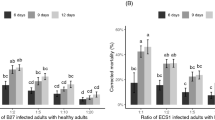Abstract
Phytophthora palmivora (Butl.) Butl., the causal agent of black pod of cocoa (Theobroma cacao L.), accounts for an estimated 19% crop loss in Ghana1, and losses are considerably higher in wetter countries such as Nigeria and the Cameroun Republic. The epidemiology of the disease is still uncertain but rain-splash from soil is considered by some workers2,3 to trigger-off disease cycles.
This is a preview of subscription content, access via your institution
Access options
Subscribe to this journal
Receive 51 print issues and online access
$199.00 per year
only $3.90 per issue
Buy this article
- Purchase on Springer Link
- Instant access to full article PDF
Prices may be subject to local taxes which are calculated during checkout
Similar content being viewed by others
References
Blencowe, J. W., and Wharton, A. L., Rep. 6th Commw. Mycol. Conf. Kew, 139 (1961).
Grimaldi, J., Rep. Cocoa Conf., London, 90 (1957).
Okaisabor, E. K., Nigerian Agric. J., 2, 67 (1965).
Strickland, A. H., Rep. W. Africa Cocoa Res. Inst., 1947-48, 33 (1949).
Thorold, C. A., Nature, 170, 718 (1952).
Wharton, A. L., Rep. W. Afr. Cocoa Res. Inst., 1954-1955, 56 (1955).
Okaisabor, E. K., Third Intern. Cocoa Res. Conf., Accra, Ghana, 1969 (in the press).
Thorold, C. A., Trans. Brit. Mycol. Soc., 38, 435 (1955).
Weststeijn, G., Ann. Rep. Cocoa Res. Inst. Nigeria, 1966-1967, 75 (1968).
Author information
Authors and Affiliations
Rights and permissions
About this article
Cite this article
EVANS, H. Transmission of Phytophthora Pod Rot of Cocoa by Invertebrates. Nature 232, 346–347 (1971). https://doi.org/10.1038/232346a0
Received:
Issue Date:
DOI: https://doi.org/10.1038/232346a0
This article is cited by
-
Effect of heat-treatment on the structural and optical properties of Cu2S thin films deposited by CBD method
Journal of Materials Science: Materials in Electronics (2014)
Comments
By submitting a comment you agree to abide by our Terms and Community Guidelines. If you find something abusive or that does not comply with our terms or guidelines please flag it as inappropriate.



